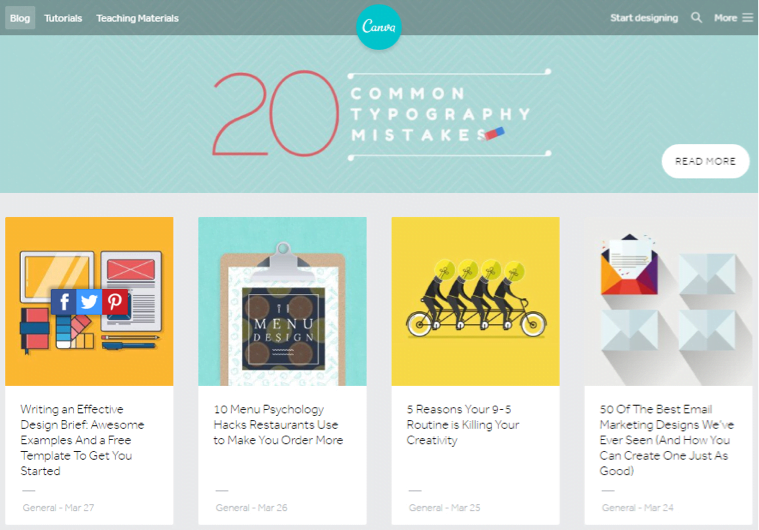Content marketing is one of the most effective strategies in a marketer’s bag of tricks. We’ve all heard some of the success stories focused on how much content has been helping big businesses like Red Bull or American Express grow, but when we look a bit further, we notice that it can be a challenging initiative to tackle for smaller companies with limited resources and tight budgets.
How to Achieve Big Content Marketing Wins as a Small Business
However, these constraints should not defer your small business from creating your own content marketing strategy and attempting some big wins along the way. Content marketing is actually a very cost-effective technique for reaching your audience in the long term and should be incorporated with your other marketing channels to best cater to the needs of your growing customer base.

Although easier said than done, by following a scalable plan, small businesses can tackle the challenges of content marketing with minimal investment. This can be accomplished by leveraging a number of distribution networks that are free or low-cost to help support your content once it is published.
As an example, the small Sydney-based graphic design software company Canva utilizes their blog as a low-cost option to appeal to its audience. Canva branded their blog as a design school, which quickly resonated with their users, and within the first year, helped grow their user base to 575,000 users in just 10 months.
Even smaller organizations like Canva can create big marketing wins.
Though blogging is only one piece of the content marketing puzzle, this can be an initial starting point for your company to implement and use cost-effective strategies to achieve larger success, particularly if you are working with a tight budget.
Developing a Content Strategy
When it comes to achieving success in content marketing the first step is to literally put pen to paper. Nearly half of B2B small business marketers surveyed did not have a documented content strategy. This can be quite troubling because it becomes difficult to see where your hard work is headed if you don’t have a written objective.
Begin by creating a clear plan that is structured around your organization’s marketing goals. Throughout this process, jot down short and long-term ideas and develop stepping stones on how you can best achieve these. Ask yourself what content would be appealing to your audience and how you can best deliver that message to them.
When initially developing your strategy, don’t overthink it. Yes, you are going to want to cover every angle (and in due time you will) but it’s far too common to overwhelm yourself with a mountain of to-do’s and become discouraged. Keep your plan simple and actionable, you’ll learn how to incorporate more tactics as you find what works most effectively for your organization.
Additionally, you will begin to understand the importance of writing your ideas down and creating a concise plan of action moving forward. This tends to help you stay on track when other initiatives begin competing for your attention and doing so will help you move closer to achieving success with your content marketing strategies.
If it’s your first time creating a content marketing strategy, you’ll want to fully invest in understanding how to plan your content and learn the best techniques to leverage for your organization’s marketing needs.
Produce and Repurpose Different Types of Content
With your content calendar created, start turning your ideas into actual content. You’ll want to experiment with a mixture of content to help determine which performs better with your readers. Try webinars, ebooks, white papers, videos, flyers, blog articles, etc. based on what your audience will most likely consume and what ties back to your business offerings best.
Even though you will be producing a variety of content, try not to overly complicate the process and start by creating one or two different types of content to see what works for your business. Stick with your organization’s expertise to begin building your brand as a genuine authority within your industry as it relates back to your product and service offerings. This content can help illustrate that you are well-rounded, experienced in the subject matter of interest to your audience, that your company is trustworthy and reliable, and that your organization is interested in becoming a valued contributor to your greater community.
You will likely be investing a significant amount of time developing your ideas into content, since creating great content requires careful attention to detail and is often a lengthy process. This may prove to be a daunting challenge, but fortunately, outsourcing can be an option that lifts some of the heavy burdens and helps guide your content marketing efforts toward success.
Writing and design work are some of the most commonly outsourced projects, as these tasks generally require a hefty amount of resources that small businesses may not be capable of supplying internally. There are a variety of outsourcing services available, such as Elance, Odesk, and Fiverr, but regardless of your decision, you’ll want to ensure that your objectives are agreed upon with the freelancer at the outset of the contract to ensure you’ve chosen the right freelancer to help with your efforts.
Small businesses can also look to stretch their resources further by repurposing their content marketing ideas into several unique content pieces. This can extend your content’s longevity by expanding one idea into multiple formats, such as turning a popular blog article into a podcast, slideshow, infographic, ebook, white paper, video, or webinar topic.
Incorporating a content repurposing strategy can considerably shorten content creation time, as many of the elements are recycled over multiple pieces of content. These techniques can help you get the most out of your content and may solve some of your content marketing woes as a small business.
Don’t Neglect the Distribution of Your Content
Once you’ve developed your own content, ensure that you spend the time distributing it effectively. There are a variety of ways to distribute your content, but you’ll need to determine which are best for your organization and customer base.
Each audience is unique, which requires marketing your content on the channels where they are most active. If you are unsure which channels will work best for your organization, start researching the demographics of the major distributions networks available and get to know your audience’s habits and preferences to inform your decisions.
A great starting point for distributing your content is to utilize the established audiences of others in your industry, whether on social media, an industry blog, or elsewhere. The goal is to identify which communities are similar to the community online that you’d like to establish and then devise ways of reaching them on a regular basis. There are many tactics to reach these relevant audiences with your valuable content.
Try guest blogging on niche blogs in your industry, interview leaders in your community, curating the content of others to generate good-will or partner with industry influencers to build off of their expertise and following, all of which are generally free and merely cost your team their time, effort, and expertise.
When researching social influencers to help promote your brand, ensure that their network is relevant to the target market for your content, as there is little value in growing an audience full of unqualified consumers.
To create a powerful relationship with an influencer, look to garnish a win-win scenario for both parties. This may be easier to accomplish if you first reach out to them and discover what content they are happy to share. Then be sure to deliver that to them on a regular basis.
It’s worth noting that one of the tactics Canva used to generate success with their content is bringing on Guy Kawasaki as their Chief Evangelist. Not every business will be able to bring on such a high-profile influencer from the beginning, but there are many different levels of influencers to work with and a variety of levels of partnership worth exploring to help boost the visibility of your content.
Content distribution challenges may seem intimidating, but by experimenting with a variety of outreach techniques, and pushing strong and relevant content, small businesses can look to build upon this momentum and start generating wins with their content marketing.
Determine What Makes Your Content a Success
When first defining your metrics for success, focus on a few key elements that illustrate traction within your campaign. The most important metrics will differ based on your organization’s needs and goals, but to start, look for an increase in traffic to your website. Whether your content was published in a magazine or an ebook, you’re likely to draw attention back to your brand’s website, whether this is your intention or not.
You’ll want to look for any increases in traffic, which can often be a sign that your content is beginning to resonate with your audience, and can be measured through an analytics platform. While traffic doesn’t necessarily equate to success, (or sales for that matter) it can be a strong indication that your content marketing has begun to gain traction and should be used as a reference point when making adjustments to your campaigns. You may also identify traction in the beginning by looking into other metrics for success, such as average time on site or the number of pages visited per session.
I recommend analyzing your datasets using Google Analytics or another platform to track what your visitors are most interested in consuming on your website. If you aren’t currently using an analytics platform to measure this data, there are many free and cost-effective solutions to use that can be very beneficial when trying to understand what is and isn’t working from your content efforts.
Analyzing your data, (referred to as research in the below diagram) is an imperative step that completes the content marketing cycle, a cycle that should be repeated consistently to drive results and provide actionable data over and over again.
In an earlier post, Peter Borden explained why marketers need to have a love for analytics. “Digging into the deep data of an analytics dashboard doesn’t come naturally, particularly when that data represents some fairly abstract relationships. But the more you understand the story your analytics are telling you, the better equipped you are to reach your audience, grow your numbers, and increase conversions.”
When you find content that best resonates with your audience, take detailed notes on why you think they enjoyed it. Was it the format, network or image that you used that helped move the needle? Begin to scale your successes by monitoring patterns in your data and developing similar content based on what worked.
Again, this may be easier said than done, but by now you have a better understanding of how to prioritize the creation and publishing of content that your audience really loves especially since you’ve got limited time and resources. The success of your content tends to correlate with how much you understand about your demographic and the research that you’ve completed to inform your content efforts.
By creating a cohesive content strategy, utilizing low-cost distribution channels, and analyzing your most effective content, you will be more prepared to achieve big content marketing wins, regardless of the size of your organization or the challenges that lay ahead.
How has your business used content marketing to achieve big wins? Do you agree with the need to dig deep into your analytics? What tips would you share with other marketers working through their first content strategy? Leave your answers in the comments section.







Leave a Comment
You must be logged in to post a comment.